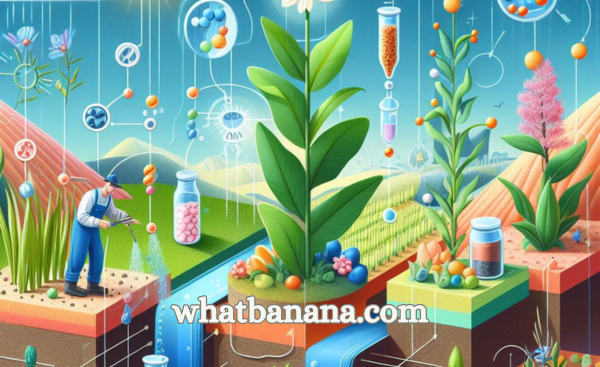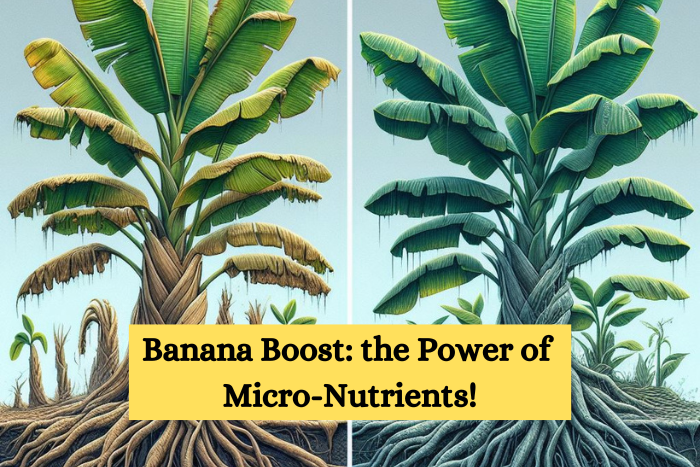Banana plants, known for their lush green foliage and sweet, nutritious fruit, are a staple crop in many parts of the world.
The cultivation of these plants is not just an agricultural activity but a crucial economic backbone for numerous communities globally.
However, the journey from planting to harvest is fraught with challenges, the most significant of which involves ensuring optimal plant health.
Among various factors, the micro-nutrient needs of banana plants play a pivotal role in their growth and fruit production.
Micro-nutrients, though required in smaller quantities compared to macro-nutrients, are essential for the well-being of banana plants.
These trace elements, including iron, manganese, zinc, copper, and boron, are crucial for various physiological functions within the plant.
They aid in processes ranging from chlorophyll production to enzyme activation, and their deficiency can lead to stunted growth, poor yield, and even plant death.
Therefore, understanding and managing the micro-nutrient requirements of banana plants is critical for farmers and cultivators aiming for a bountiful harvest.
However, identifying the precise micro-nutrient needs and addressing them effectively can be complex.
Banana Bonanza: The Secret Micro-Nutrients You Need!
Factors like soil composition, climate, plant variety, and cultivation practices all influence the micro-nutrient uptake by banana plants.
Furthermore, symptoms of micro-nutrient deficiencies can often be subtle or misinterpreted, leading to inadequate or incorrect interventions.
This article delves into the intricate world of micro-nutrients for banana plants.
We will explore the key micro-nutrients vital for their health, understand the signs of their deficiencies, and discuss effective ways to replenish these nutrients in the soil.
Additionally, we’ll offer insights into balancing these micro-nutrients to avoid the detrimental effects of both deficiency and excess.
Whether you are a commercial banana grower, a small-scale farmer, or an enthusiast in plant cultivation, this guide aims to equip you with the knowledge to nurture healthier, more productive banana plants.

Understanding Micro-Nutrients in Plant Health
Micro-nutrients, though required in trace amounts, are fundamental to the health and growth of plants, including banana plants.
These elements, while only needed in minute quantities, are indispensable in supporting a wide array of biological functions.
They act as catalysts in various biochemical processes, playing a vital role in the plant’s life cycle from germination to fruiting.
At the core of their importance is their involvement in enzymatic reactions.
Enzymes, which are proteins that speed up chemical reactions in plant cells, often require the presence of specific micro-nutrients to function effectively.
For instance, zinc is a key component of many enzymes and is involved in the synthesis of plant hormones, protein formation, and growth regulation.
Similarly, manganese activates enzymes responsible for plant growth and metabolism, particularly in photosynthesis and nitrogen assimilation.
Micro-nutrients also contribute to the synthesis and functioning of chlorophyll, the pigment responsible for the green color of plants and crucial for photosynthesis.
Iron, for example, is essential for chlorophyll synthesis and is a component of proteins involved in electron transport during photosynthesis.
A lack of iron can lead to chlorosis, a condition where leaves fail to produce sufficient chlorophyll, resulting in a yellowish appearance.
Moreover, micro-nutrients play a significant role in the structural integrity of plants.
Elements like boron are vital for maintaining cell wall structure and function.
Boron deficiency can lead to weakened cell walls, resulting in stunted growth and malformed plant parts.
The role of micro-nutrients extends to the plant’s ability to withstand stress conditions such as diseases, pests, and environmental stressors.
Adequate micro-nutrient levels can enhance a plant’s resistance to such challenges, promoting overall health and longevity.
In summary, micro-nutrients are crucial for the healthy growth and development of banana plants.
They are involved in critical biochemical processes, from enzymatic functions and chlorophyll synthesis to structural integrity and stress resistance.
Understanding the role and importance of these micro-nutrients is key to effective plant management and ensuring the health and productivity of banana crops.

Key Micro-Nutrients for Banana Plants
Iron (Fe)
Iron plays a crucial role in the synthesis of chlorophyll, the green pigment responsible for photosynthesis in banana plants.
A sufficient iron supply ensures that plants can efficiently convert sunlight into the energy needed for growth.
When iron is deficient, one of the most noticeable symptoms is chlorosis, where new leaves or leaf veins turn yellow or pale while the veins remain green.
This condition limits the plant’s ability to photosynthesize, stunting its growth.
To address iron deficiency, soil amendments with iron chelates are effective.
Foliar sprays containing iron can also be used, providing direct absorption through the leaves.
It’s important to apply these treatments in the correct dosages and conditions to avoid toxicity and ensure optimal uptake by the plant.
Manganese (Mn)
Manganese is integral to several enzyme systems in banana plants, particularly those involved in nitrogen metabolism and the synthesis of various proteins.
It also plays a role in the photosynthetic process, particularly in the splitting of water molecules.
Signs of manganese deficiency include interveinal chlorosis, where the area between the leaf veins becomes pale or yellowish, while the veins remain green.
Necrotic brown spots may also appear on leaves.
To counteract manganese deficiency, soil applications of manganese sulfate are common.
Alternatively, foliar sprays can provide a more immediate remedy, as they allow the plant to absorb manganese directly through its leaves.
Regular monitoring of soil pH is essential since high pH can reduce the availability of manganese to the plant.

Zinc (Zn)
Zinc is vital for the growth and fruit development of banana plants, influencing hormone production, protein synthesis, and internode elongation.
Zinc deficiency typically manifests as stunted growth, with shorter internodes leading to a rosette formation.
Leaves may become smaller and thinner, and their edges may curl upwards.
To combat zinc deficiency, applying zinc sulfate either to the soil or as a foliar spray can be effective.
In areas with zinc-deficient soils, regular applications may be necessary to maintain adequate levels.
Chelated forms of zinc are also available and can be more readily absorbed by the plant.
Ensuring proper application timing and method is crucial for the effectiveness of zinc supplementation.

Copper (Cu)
Copper is essential for various physiological processes in banana plants, including photosynthesis, respiration, and lignin synthesis, which contribute to the structural strength of the plant.
Copper deficiency is less common but can lead to a range of symptoms, including young leaves remaining dark green and becoming twisted or misshapen.
The growth of new shoots might also be inhibited.
To rectify copper deficiency, soil application of copper sulfate is often recommended.
In severe cases, foliar sprays can provide a quicker response.
However, care must be taken with copper applications, as excessive amounts can be toxic to the plant and soil microorganisms.
Regular soil testing is advisable to monitor copper levels and ensure they remain within an optimal range.

Boron (B)
Boron is critical for cell wall synthesis and the overall structural integrity of banana plants.
It also affects cell division, nutrient transport, and carbohydrate metabolism.
Boron deficiency often leads to the death of meristematic tissues in the growing tips of roots and shoots, resulting in stunted growth and rosetting of leaves.
Hollow heart disorder in the fruit is another common symptom.
To address boron deficiency, applications of borax or other boron-containing fertilizers to the soil are effective.
Foliar applications can also be used for a quicker response.
Since boron is not highly mobile within the plant, regular applications may be needed.
However, as with copper, caution is advised since boron can be toxic at high concentrations, so it’s crucial to apply it judiciously and monitor soil levels regularly.

Balancing Micro-Nutrient Supply
Achieving a balanced micro-nutrient supply is essential for banana plants’ optimal growth and health.
This balance is a delicate interplay between the soil’s properties, the plant’s needs, and environmental factors.
Over- or under-supply of any single micro-nutrient can disrupt this equilibrium, leading to deficiencies or toxicities that can adversely affect plant health and yield.
The first step in balancing micro-nutrients is through soil testing.
Regular soil tests provide invaluable information on the nutrient composition and pH levels, which influence nutrient availability.
Based on these results, precise amendments can be made to correct any imbalances.
For instance, in alkaline soils where certain micro-nutrients become less available, soil acidifiers can increase their bioavailability.
It’s also crucial to consider the interaction between different micro-nutrients.
Excessive levels of one element can sometimes inhibit the uptake of another, creating deficiencies despite adequate soil levels.
For example, high levels of manganese can interfere with iron absorption.
Therefore, a comprehensive approach, considering all micro-nutrients, is necessary rather than focusing on a single element.
In addition to soil amendments, foliar applications can be used to address immediate deficiencies.
These are particularly useful during critical growth stages when plants require a rapid supply of specific nutrients.
However, foliar feeds should complement, not replace, soil management strategies.
Lastly, understanding the specific needs of banana varieties and adapting the nutrient management plan accordingly is vital.
Each variety may have different sensitivities and requirements, which should be considered when planning micro-nutrient applications.
Balancing micro-nutrients is a dynamic process that requires continuous monitoring and adjustment.

FAQs on Micro-Nutrients for Banana Plants
1. How often should micro-nutrients be applied to banana plants?
Micro-nutrient applications should be based on soil test results and plant growth stages, typically once or twice a year. Regular monitoring of plant health and soil conditions can help determine the need for additional applications.
2. Can micro-nutrient deficiencies be corrected during the growing season?
Yes, micro-nutrient deficiencies can often be corrected during the growing season using foliar sprays for immediate uptake. However, it’s essential to identify the specific deficiency accurately and apply the correct micro-nutrient formulation.
3. What are the risks of micro-nutrient toxicity in banana plants?
Micro-nutrient toxicity can lead to stunted growth, leaf burn, and even plant death if excessive amounts are applied. It’s crucial to adhere to recommended dosages and application methods to avoid such risks.
4. Is it necessary to use chelated forms of micro-nutrients for banana plants?
Chelated micronutrients are beneficial as they are more readily absorbed by plants and reduce the risk of soil fixation. They are particularly useful in alkaline soils where certain micro-nutrients become less available.
5. How do I know if my banana plants are suffering from a micro-nutrient deficiency?
Signs of micro-nutrient deficiency in banana plants include chlorosis, stunted growth, leaf deformities, and poor fruit development. Soil and tissue testing can provide definitive diagnoses of specific deficiencies.
6. Are organic fertilizers effective in supplying micro-nutrients to banana plants?
Organic fertilizers can be effective in supplying micro-nutrients, particularly if they are derived from sources rich in these nutrients. However, their nutrient content can vary, so they should be used in conjunction with soil testing and balanced with other fertilization methods.

Advanced Techniques in Micro-Nutrient Management
Advanced techniques in micro-nutrient management for banana plants involve a blend of precision agriculture, enhanced formulations, and innovative application methods.
One such technique is the use of soil and leaf tissue analysis, which provides accurate insights into the specific nutrient needs of the plants, allowing for targeted interventions.
This precision approach ensures that micro-nutrients are supplied in the exact quantities needed, minimizing waste and preventing toxicity.
Another advancement is the use of chelated micro-nutrients, which are more readily absorbed by plants.
Chelates protect micro-nutrients from becoming bound in the soil, enhancing their availability to the plant roots.
This is particularly beneficial in soils with high pH levels, where micronutrient availability is typically lower.
Innovative application methods like fertigation, where fertilizers are applied through the irrigation system, and foliar applications using nano-fertilizers are gaining popularity.
These methods ensure a more efficient and direct delivery of nutrients to the plants.
Nano-fertilizers, in particular, offer the advantage of releasing nutrients slowly and over a prolonged period, enhancing their uptake efficiency.
Additionally, integrating organic matter into the soil can improve its structure and nutrient-holding capacity, thus enhancing micro-nutrient availability.
The use of composts and organic mulches not only supplies micro-nutrients but also supports soil health, contributing to the overall nutrient management strategy.
These advanced techniques in micro-nutrient management are transforming how nutrients are supplied to banana plants, leading to healthier growth, better yields, and sustainable cultivation practices.

My Final Thoughts
Understanding and managing the micro-nutrient needs of banana plants is fundamental for their healthy growth and optimal fruit production.
By embracing both traditional practices and advanced techniques, cultivators can ensure a balanced nutrient supply, leading to robust plants and bountiful harvests, thereby sustaining both the crop and the communities that rely on it.
